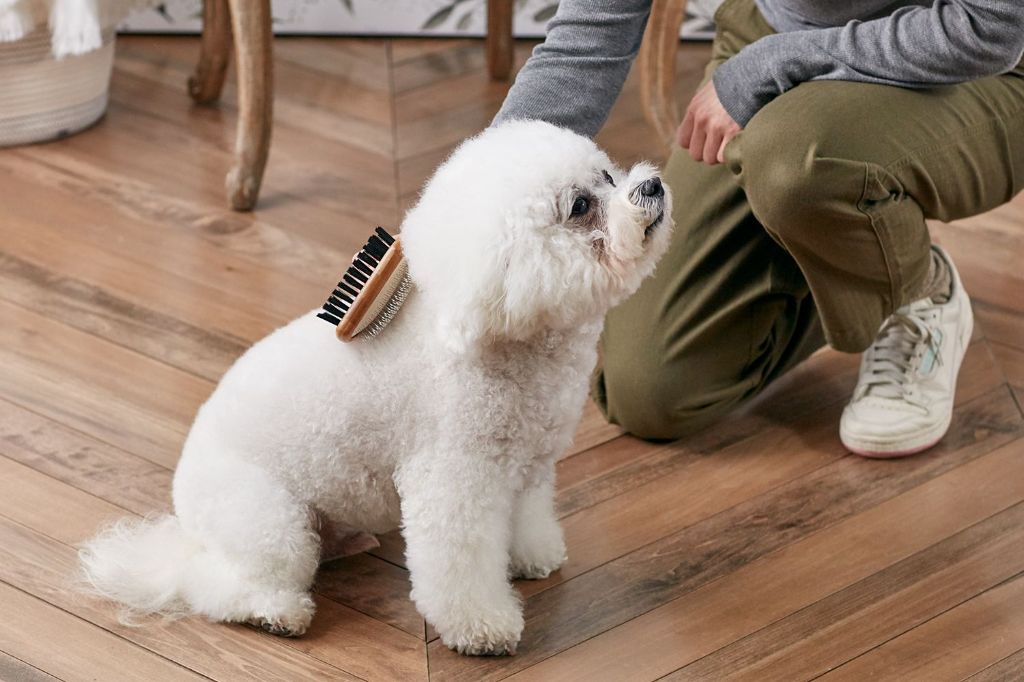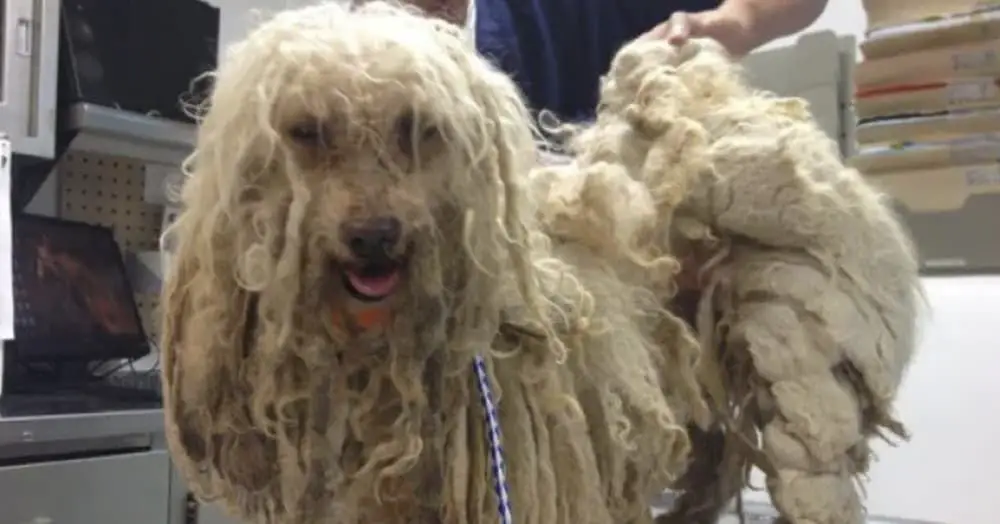Benefits of Detangling Dog Hair

Detangling a dog’s coat regularly provides several benefits for both the dog and owner. Detangling helps prevent knots and mats from forming in the first place. Matted, tangled fur can be painful for a dog, especially when trying to brush through the coat. Detangling allows the brush to glide through the hair smoothly without pulling or discomfort.
Keeping the coat free of tangles also improves overall coat health. Tangles trap dirt, debris, and moisture close to the skin that can cause skin infections or irritations. Brushing thoroughly while detangling removes those trapped irritants and allows the skin to breathe.
Regular detangling enables owners to fully brush through all areas of the dog’s coat to inspect the skin for any abnormalities like hot spots, fleas, ticks, etc. Owners can also check for any unusual lumps or bumps that may need veterinary attention.
According to this source, conditioning sprays make detangling easier by lubricating and softening the hair strands so brushes glide through tangle-free.
Potential Issues With Knots and Mats

Knots and mats in a dog’s coat can cause several problems if left untreated. According to Woof Gang Grooming What Your Groomer Wants You To Know About Matting, as mats tighten they pull on the hair follicles causing pain and can even lead to hair loss. Preventive Vet notes mats can trap moisture, dirt, and debris next to the skin leading to irritation and even skin infections Why Your Dog’s Coat Gets Matted — and What You Can Do About It. Matted hair also prevents air circulation to the skin, exacerbating skin issues.
It’s important to regularly brush and comb your dog’s coat to prevent painful mats and knots from forming. Pay close attention to areas prone to tangles like behind the ears, under the arms, and around the hind legs and tail. Addressing mats early before they tighten and pull fur can help minimize discomfort.
When to Detangle
It’s important to regularly brush and comb your dog’s coat to prevent tangles and mats from forming. Trying to detangle severely matted hair can be painful and stressful for your dog. It’s best to detangle your dog’s coat in sections, starting from the bottom near the skin and working up towards the ends of the hair. Take your time and be patient, gently working out knots instead of pulling or ripping through them. Detangling before bathing can allow the shampoo and water to penetrate down to the skin more easily. After a bath, it’s crucial to thoroughly detangle the coat while it’s still wet, as the hair is more pliable and less likely to tangle up again as it dries. Set aside adequate time for the detangling process and consider doing it in multiple short sessions if your dog gets antsy. Staying calm and using a soothing voice will help keep your dog relaxed as well. Regularly detangling small sections is key to preventing painful mats.
Coconut Oil as a Detangling Agent

Coconut oil is a popular natural oil that can be very effective as a detangling agent for dogs. Coconut oil contains fatty acids that help to moisturize, soften, and lubricate hair, making it easier to brush through tangles without breakage or irritation.
Coconut oil has several properties that make it beneficial for detangling:
- Natural moisturizer – Coconut oil helps hydrate dry, brittle hair and prevents breakage.
- Lubricates and softens – Coconut oil coats the hair shafts and allows a comb to smoothly glide through knots and mats.
- Anti-bacterial and anti-fungal – Coconut oil can help treat and prevent skin infections that may occur under mats.
- Soothing on skin – Coconut oil is gentle and nourishing for irritated or scratched skin caused by mats.
- Easily absorbed – Coconut oil penetrates hair strands without leaving a heavy residue.
Studies have found coconut oil to be just as effective as mineral oil for conditioning hair. The moisturizing oils in coconut oil can help loosen tangles and allow combs to pass through smoothly with less pulling and breakage. Its light consistency also makes it easy to apply directly to specific mats and work through knots.
“How to Make Coconut Oil Hair Detangler for Dogs.” Pinterest, 4 Dec. 2015.
Application Tips
When applying coconut oil to detangle dog hair, follow these tips for best results:
Rub a small amount of solid coconut oil between your palms to melt it before application. The friction helps liquefy the oil so it can be distributed through the coat more easily.
Once melted, massage the coconut oil thoroughly into your dog’s coat, focusing on the ends and any knotted areas. Be sure to get the oil down to the skin level.
Let the oil sit for 5-10 minutes so it can fully penetrate the hair. This softens the hair and makes detangling much easier.
Use a wide-toothed comb or slicker brush to gently work through tangles and mats while brushing. The coconut oil will help lubricate and loosen knots.
Rinse with lukewarm water after brushing to remove excess oil. Avoid using shampoo as it will strip the remaining oil from the coat.
For more stubborn tangles, you may need to apply coconut oil and brush multiple times over several days. The oil will continue penetrating the hair over time, making it easier to fully detangle.
Regular coconut oil treatments can help prevent knots and keep your dog’s coat soft, shiny, and easy to maintain.
Suggested Detangling Tools
When detangling your dog’s hair, having the right tools can make the process easier and more effective. Here are some of the top recommended detangling tools:

A wide-tooth comb is a must-have for working through tangles and knots. The wide teeth help grab and unravel matted hair without pulling or breaking the strands. Work in small sections and hold the hair above the tangle as you comb downwards.[1]
A slicker brush with fine, wire pins can help remove loose hair and prevent future tangles. Use gentle strokes and avoid scratching the skin. This works best on short-haired breeds.[1]
A de-shedding tool or undercoat rake helps remove loose hair from the undercoat, which can form mats if not brushed out. Use an undercoat rake before brushing to get rid of excess hair.[2]
A detangle spray or conditioning spray adds slip to the hair, making it easier to comb through knots. Spritz lightly before brushing. Opt for a natural formula without harsh chemicals.[1]
Investing in quality grooming tools and using them regularly can help minimize painful tangles and keep your dog’s coat healthy.
[1] https://www.rover.com/blog/dog-dematting-tools/
[2] https://www.amazon.com/Best-Sellers-Dog-Dematting-Tools/zgbs/pet-supplies/2975367011
Breeds Prone to Tangles
Certain breeds are more prone to getting tangles and mats in their fur than others. This is especially true for long-haired breeds. Some examples of dog breeds that frequently get tangled fur include:
Yorkies – The long, silky hair of Yorkshire Terriers is prone to tangling and matting if not brushed frequently.
Shih Tzus – This breed has a long, flowing coat that can easily become a matted mess without proper grooming.
Maltese – The long, white coat of Maltese dogs needs daily brushing to prevent painful tangles and mats.
Collies – Collies have thick, lush coats that can mat close to the skin if not properly maintained.
Huskies – Double-coated breeds like Siberian Huskies shed a lot, and loose undercoat can tangle if not brushed out.
Regular brushing, combing, and professional grooming can help keep these prone breeds tangle-free and comfortable.
Other Detangling Tips
Here are some additional tips for preventing and gently detangling mats and tangles in your dog’s coat:
- Mist the coat with water or a detangling spray before brushing. This helps lubricate the hair strands and allows the brush to glide through more smoothly.
- Work in small sections. Don’t try to brush the entire coat all at once. Gently work out mats and tangles in one area before moving on.
- Avoid bathing too frequently, as this can dry out the coat. Stick to once a month or less for most breeds.
- Brush thoroughly and regularly. Frequent brushing helps prevent tangles from forming in the first place. Focus on areas prone to matting.
With patience and the proper technique, you can safely work out mats and knots without causing pain or damage to your dog’s skin and coat.
When to Seek Help
Despite your best efforts at home, sometimes mats and tangles can become too severe to properly detangle on your own. According to experts at Hound Therapy, if you are unable to brush out mats and your dog is showing signs of skin irritation, it is best to seek professional help from a groomer or veterinarian (https://www.houndtherapy.com/blog/matted-dog-fur/).
Signs that professional assistance is required include:
- Mats that are large, tightly wound, and impossible to gently work apart.
- Red, inflamed, or broken skin under mats.
- Signs of pain or discomfort when brushing mats.
- Strong odor coming from skin under matting.
- Sores, scabs, or open wounds due to matting rubbing on skin.
In severe cases, the hair may need to be shaved down to properly remove matted fur and treat any underlying skin conditions. Leaving severe mats unattended can cause skin infections, pain, and unnecessary suffering for your dog. It’s important not to delay seeking professional grooming assistance if you cannot resolve mats at home.
Summary
Keeping your dog’s coat free of tangles and mats is important for their health and comfort. Detangling helps avoid skin irritation, parasites, and problems with shedding. Using coconut oil to detangle dog hair is an effective, natural solution. The fatty acids in coconut oil help lubricate the hair strands, making them easier to gently brush apart. To use coconut oil, apply it thoroughly from root to tip and let it soak in for 5-10 minutes before brushing. Use a wide-tooth comb or slicker brush and work in sections to slowly and patiently tease apart knots. Focus on trouble spots like the legs, tail, underarms, and behind the ears. Certain breeds like Poodles and Shih Tzus are more prone to tangles and will benefit from regular detangling sessions with coconut oil. With the right technique, tools, and gentle approach, coconut oil can make detangling dog hair an easier process.
